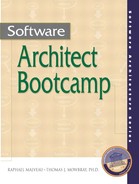2.8. Conclusions
In this chapter we introduced the fundamental concepts of object orientation, open systems, and object-oriented architectures. We learned that object orientation helps to isolate changes in software systems by combining the data and processing into modules called objects. Object technology is a capability which is already present and entering the mainstream of software development. Object technology is broadly supported by commercial industry through software vending and by many mainstream end-user organizations in their application development.
We learned that the only sustainable commercial advances are through open systems forms of commercial technology. With proprietary technologies, the obsolescence of capabilities conflicts with the need to build stable application environments which support the extension of application functionality.
We learned that stovepipe systems are the pervasive form of application architecture but can be reformed into more effective component object architectures. In the next chapter we will describe object technologies and various reference models which make these technologies understandable.
In this chapter we talked about one of the key concepts in object-oriented architecture—the application of standards in software development. Proper understanding of how standards are utilized is very important to the successful exploitation of commercial technologies and the interoperability of application functions.
In this chapter we also described object-oriented client server technologies with a focus upon the underlying distributed computing capabilities and how they compare with related technologies from the procedural generation. We discovered that the companies supplying these technologies have highly overlapping interests which are expressed through commercial standards consortia and formal standards bodies. We discussed how distributed computing environments vary from the CORBA mechanism to the Microsoft technologies that are more closely related to remote procedure call. Finally, we described some of the details of CORBA infrastructure and how they relate to the Cargill model.
In conclusion, a wide range of open systems client server technologies support object orientation. These technologies enable the construction of a wide array of distributed systems based upon objects and components.
